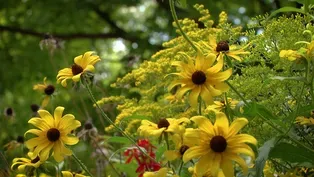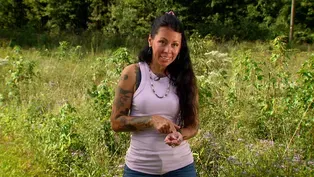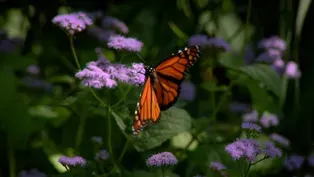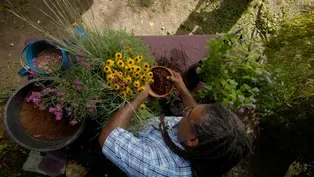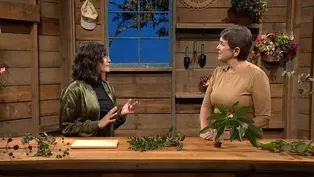Virginia Home Grown
Native Roots, Fruits & Nuts
Clip: Season 23 Episode 7 | 7m 1sVideo has Closed Captions
Learn about Virginia native food plants
Paul Cipriani, from The Living Earth School, demonstrates food uses for native plants including pawpaw and cattail. Featured on VHG episode 2307; September 2023.
Problems with Closed Captions? Closed Captioning Feedback
Problems with Closed Captions? Closed Captioning Feedback
Virginia Home Grown is a local public television program presented by VPM
Virginia Home Grown
Native Roots, Fruits & Nuts
Clip: Season 23 Episode 7 | 7m 1sVideo has Closed Captions
Paul Cipriani, from The Living Earth School, demonstrates food uses for native plants including pawpaw and cattail. Featured on VHG episode 2307; September 2023.
Problems with Closed Captions? Closed Captioning Feedback
How to Watch Virginia Home Grown
Virginia Home Grown is available to stream on pbs.org and the free PBS App, available on iPhone, Apple TV, Android TV, Android smartphones, Amazon Fire TV, Amazon Fire Tablet, Roku, Samsung Smart TV, and Vizio.
Providing Support for PBS.org
Learn Moreabout PBS online sponsorshipWell, Paul, you've got quite an array of, I'll say, roots and and fruits here, as well as some nuts.
>>Yeah.
>>So where would you like to start?
Because there's so much to share and so much to talk about.
>>Yeah.
These are all fruits or edible portions of plants that are available right now.
Over here, there's this passion fruit vine, which has this amazing purple flour that it gets.
And it kind of takes over the place.
Vining everywhere, comes up, sends its roots to the soil.
>>Yes, yes.
>>And it gets this fruit, which this fruit isn't ripe right now.
>>No, it's still a little early.
>>Yeah.
>>But how much longer do you think?
>>I'm not sure.
>>Okay.
>>That's a good question.
But you can tell when they start to wrinkle up and they'll get soft.
But I think we should dissect it and see what's inside.
>>Okay.
That's good >>Because I think people will be familiar with passion fruit.
You can see that it's got those, just massive seeds on the inside.
>>Yes.
>>Yeah.
>>And I think so many people, this is a great little treat, but the wildlife love it as well.
>>Yes.
>>It's very, very popular- >>Yes.
>>With the wildlife.
But some people make jams and jellies out of it.
>>Yeah.
It's very delicious.
>>Have to get those seeds out though.
>>Yeah, yeah.
Yep.
>>But passion fruit is a fruit is, one, the passion vine, it grows like in a part-shade shade situation.
And it just really can be, I wanna say, aggressive in the garden.
>>Yes.
It's very prolific for sure, yeah.
>>But if you're growing it for the fruit- >>Yeah.
Yeah.
>>You've gotta balance it all.
>>It's a beautiful plant.
>>It is a beautiful plant with a beautiful flower.
So to go from passion fruit though to something not as pretty, what's next on our list?
>>Well, I brought in some pieces of the cattail root.
>>Uh-huh.
>>This root right now, the, the cattails are, they're kind of tailing off towards the end of the season here and they're starting to put their energy down into their roots.
>>Okay.
>>So the roots are full of starch.
>>Oh, okay.
>>And this starch, you can see on the outside, it's just got this brownish skin.
But when you split it, it's got these white fibers.
>>Okay.
>>And the white is the starch that you can harvest from it.
I've actually got this little jar here.
I wash some of the starch out from the fibers last night.
And what you do is you take the root and mash up the fibers underwater, and the starch comes into the water and then it settles to the bottom of the bowl.
>>Uh-huh.
>>And then once it's settled, you can pour the water off and then use that flour.
You can mix it into just like regular bread flour or you can dehydrate it and set it aside.
Or you could just take the starch and like boil it as a porridge or something like that.
And it's just high in carbohydrates.
And when you cook it, it actually gets kind of sweet.
It's actually- >>So the starch just changes.
>>I don't if say delicious.
>>Yeah >>But it's a unique taste out in the woods.
>>Okay.
So do you like peel that off?
>>Yeah.
Yeah, you peel it apart and you can see that- >>Oh my, I see it now.
>>It's full of fibers.
>>Yes.
>>And then when you scrape it, there's all this like white goo, which is the starches that's in there.
>>Okay.
>>Yeah.
>>That's interesting, very interesting.
>>And this small amount of flour that I got in here.
>>Yeah.
>>That's from like probably eight sections of root like this.
>>Okay.
>>So it's a bit time intensive to get it.
>>Pretty intensive.
>>And these are the end shoots that were at the ends of the roots.
The roots were making their way through the mud.
>>Right, yeah.
>>Ready to come up in the spring.
And these are really tender.
They just snap and they're really good sauteed or boiled.
But all cattail has to be cooked because if it's growing in a water source that has various bacterias or viruses or things like that, you want to kill off the bugs >>Oh, definitely.
>>Yeah.
>>Yes.
>>And you never wanna harvest from a place where there's runoff from roads because the cattails will actually take up heavy metals.
>>Right.
>>And other pollutants and stuff.
So this actually came from a source where I wouldn't actually eat this.
I just brought it in for a demonstration.
>>Okay.
>>You'd have to really be selective about where- >>And get permission.
>>And get permission, of course, yeah.
>>Yes.
>>And also it's in a very sensitive environment so it's not a good idea to just go out there, and it's important to the wildlife.
>>Yeah.
>>It does a lot.
>>Sounds great.
Well, let's move along 'cause our time is running along.
>>Okay.
>>So tell us about what you've got here.
Let's... >>Yeah, so I've got some of these black walnut, which is pretty common.
And I've got one that I cracked open.
In fact, this is the result of messing with this black walnut.
It dyed my skin brown.
>>I'm so sorry.
>>So you gotta keep that in mind in case you have something special to go to at the end of the day.
But I also brought a butternut in, which is a tree that is related to walnuts, but it's also called white walnut, and it's a little less common.
>>Yeah.
>>You don't find it as often.
And some of the places where we hold our programs, we have secret butternut trees.
And the kids will spend hours cracking them open- >>Wonderful.
>>And cooking 'em over the fire and stuff, yeah.
>>It's got more of a football shape.
>>It does, yeah.
>>Versus the round shape.
>>Yeah.
And it has a different flavor too.
It's almost reminiscent of banana, some people say.
>>Cool.
>>Well- >>it's good.
>>Speaking of flavor, let's keep on moving along.
We've got our sassafras here.
>>This is sassafras.
This is a tree that grows pretty commonly around this area, and it's got this beautiful color.
>>Yes.
>>And what I did was I took this root.
this is some sassafras root right here.
And I, I took a knife and peeled the outer bark of it and then simmered it for about five minutes.
And it gave me this tea.
>>Excellent.
>>Yeah.
>>Excellent.
>>Well, we have 30 seconds left.
And I wanna get to- >>Oh my goodness.
Yeah, we gotta to get to the pawpaws.
>>Then we've gotta get to our pawpaws here.
>>Yeah.
>>And real quick.
"Quick like a bunny," as my mom would say.
>>All right, we got this ripe pawpaw here.
we just gotta open this baby up 'cause it was so good.
>>And pawpaws are common throughout low wetlands, wait a minute, low wetlands.
And in order to harvest, you actually don't.
You just pick them up off the ground.
>>Yeah.
>>Because if you harvest them from the tree, and you'll find you'll have very, very bitter.
>>Yeah.
These came off the tree.
They're very hard and they're on the small size, but this is the ripe pawpaw.
Should we eat a little bit of it?
>>Let's have a little bit of a bite.
>>All right.
Then we'll save it.
But you gotta watch those seeds.
>>Yeah.
It's got these very large seeds- >>Yeah.
>>In them.
They're kind of beautiful.
And you'll find them scattered on the ground where the wildlife has been feeding on them.
That's really good.
>>That is a very good, good pawpaw.
>>That's really sweet.
Yeah.
>>Our wildlife enjoy these fruits as much as we do.
>>Yeah.
>>And it's important that when we're out walking, that we take a look around and see what's there.
>>Definitely.
>>But also to learn and to get permission.
>>Yes, definitely.
>>And to make sure that we leave plenty for the wildlife.
>>Yes.
It's more important to them than for us, for sure.
>>Yes, absolutely.
Thank you, Paul.
You're welcome.
Video has Closed Captions
Learn how native plants feed wildlife to create healthy ecosystems! (26m 46s)
Video has Closed Captions
Fall wildflower seeds bring early spring color (2m 19s)
Video has Closed Captions
Remove lawn to restore beneficial plant communities (8m 49s)
Video has Closed Captions
Discover native plants to feed people and wildlife (7m 49s)
Native Plants for the Landscape
Video has Closed Captions
Discover native plants for the home landscape (6m 19s)
Providing Support for PBS.org
Learn Moreabout PBS online sponsorshipVirginia Home Grown is a local public television program presented by VPM
